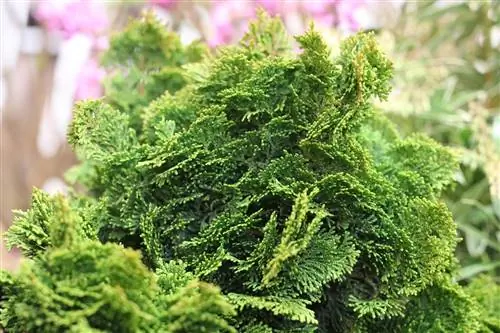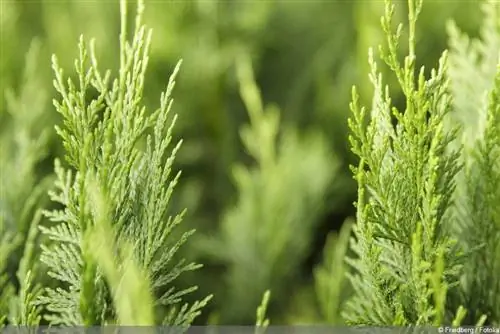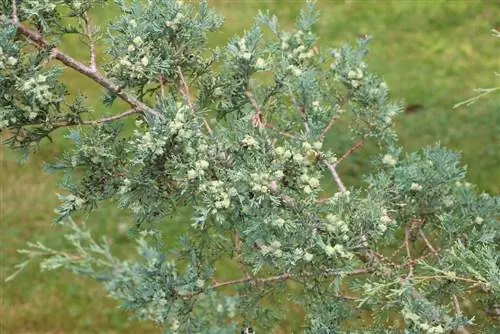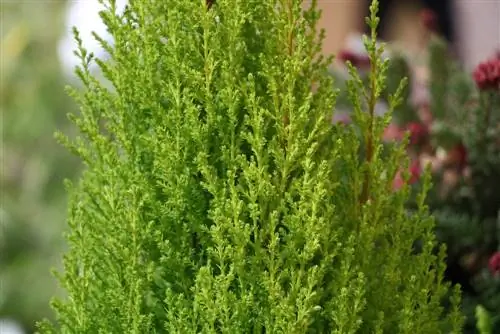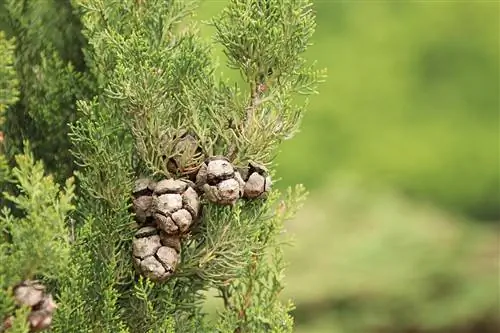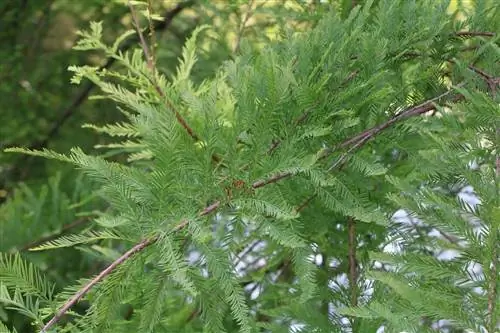- Author admin [email protected].
- Public 2023-12-17 03:39.
- Last modified 2025-01-24 12:45.
The mussel cypress, which is also known as the Hinoki cypress, impresses with its compact, bushy growth habit combined with clear maintenance requirements, which makes it suitable for beginner gardeners.
Profile of the mussel cypress
- Plant order: Conifers
- Growth height: 200 to 250 centimeters
- Growth width: 100 to 150 centimeters
- Growth habit: bushy
- Leaves: evergreen
- Leaf shape: scale-shaped
- Leaf color: green
- Flower formation: No
- Toxicity: Yes
Location Requirements
For uniform growth, the mussel cypress needs lighting on all sides. The location should therefore be in a sunny to partially shaded spot. A place that is too sunny leads to heat stress, especially in summer, so the plant should not be exposed unprotected, especially to the midday sun. Growing in a rock garden is therefore also not recommended due to the increased radiation. In contrast, a place that is too shady leads to a weaker immune system, which makes the plant more susceptible to disease.
Species with a large size are particularly recommended for outdoor planting, while small, dwarf varieties or bonsai should be used for container cultivation.
Substrate selection
The Hinoki cypress prefers well-drained and nutrient-rich soil. In addition, the soil should be characterized by a high proportion of humus and a low, acidic pH value. Soils with a high lime or clay content should definitely be avoided. Most commercially available substrate mixtures do not optimally reproduce this combination, so producing your own mixture has proven useful in practice.
Proven materials are:
- Garden soil
- Sand
- gravel
- Coconut fibers
- Lavasplit
Planting
The mussel cypress can be cultivated all year round both in pots and outdoors. However, for optimal root growth, we recommend planting outside of the frost-free period.
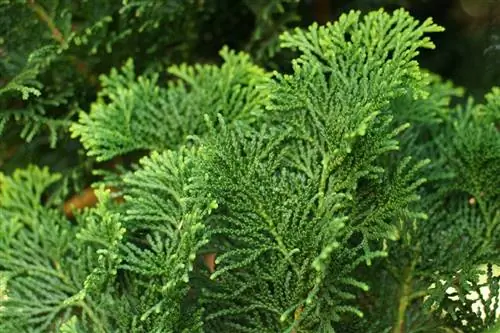
When planting, the following instructions should also be observed:
- remove old substrate from the roots
- Soak root ball generously in a water bath
- Digging a planting hole because it is at least twice as big as the root ball
- Loosening of the surrounding layers of earth
- Sink the root ball of the mussel cypress completely into the planting hole
- Filling with a mixture of excavated soil and compost or horn shavings
- Press the soil mixture firmly
- Water the plant generously
Since the conifer is a shallow-rooted plant, the root system only has a shallow root depth. In order to provide the individual plants with enough space for growth when creating a hedge or a group, a minimum distance of 50 centimeters should be maintained between the seedlings.
Tip:
The mussel cypress needs a lot of moisture, especially in the first few weeks after planting. To slow down the drying out of the soil, it is recommended to spread a layer of bark mulch around the plant.
Transplanting
Transplanting a plant means increased stress for it each time, so the advantages and disadvantages must always be weighed up in advance. Mussel cypresses transplanted in pots in particular require a new planter approximately every two to three years due to their constant growth. Due to the compact root ball in this cultivation method, transferring it to another pot is not a problem.
The situation is different with specimens transplanted into the ground. Digging up damages the sensitive root areas in particular, so there is a risk that the plant can no longer supply itself with sufficient fluids and nutrients. Therefore, no sharp tools should be used to lift the Hinoki cypress in order to minimize damage to the root ball.
Other advice to consider is:
- Time: Autumn before the first frost
- Cutting broken root shoots
- Aboveground parts of the plant should also be cut back slightly
In addition, the aforementioned instructions for planting the mussel cypress must be observed in order to encourage rapid rooting in the new location.
Tip:
To make the work easier during transplanting, both during excavation and moving, it is recommended to tie the branches of the plant with a rope to create a more compact shape.
Propagation
Chamaecyparis obtusa is propagated via cuttings, although the process is very lengthy and only partially successful. To begin with, it is necessary to cut off shoots about 15 centimeters long from the mother plant. Ideally this is done in spring as this represents the beginning of the growing season. The cut surface should be as oblique as possible in order to obtain a large wound surface, which is essential for water supply. The shoot is then freed of all leaves and sprinkled with a root powder. This promotes the development of root shoots and thus increases the chances of successful reproduction. Finally, the shoot is placed in a cultivation tray prepared with moist substrate and placed in a bright place. The formation of new leaves is a clear indication of successful propagation using the cutting method.
Pouring routine
The mussel cypress prefers the substrate to be evenly moistened. Both prolonged drought and waterlogging are not well tolerated and lead to a weakening of the immune system in conjunction with increased susceptibility to diseases and pests. To determine the optimal time for irrigation, all you need to do is examine the top layers of soil using a finger sample. If these have a dry consistency at a depth of two centimeters, renewed fluid supply is necessary.

Since Chamaecyparis obtusa has an intolerance to lime, it is imperative to take this into account when watering. The only suitable irrigation water is:
- stale tap water
- filtered water
- Rainwater
Fertilizer rules
The choice of cultivation form plays a crucial role in fertilizing the Chamaecyparis obtusa. While conifers transplanted outdoors are fertilized twice a year with a long-term fertilizer in the form of compost or horn shavings, specimens cultivated in pots require a significantly higher intensity. This is essentially due to the limited amounts of soil, which only have a limited storage capacity for nutrients. To support uniform growth, it is therefore recommended to use a special conifer fertilizer, which is added to the irrigation water every four to six weeks from March to August.
Note:
To prevent over-fertilization, a maximum of half the amount of fertilizer stated on the package should be used.
Cut
The natural bushy shape of the Hinko cypress makes regular pruning essential. Older specimens in particular do not tolerate radical pruning very well, which is why these should be avoided if possible. However, cuts up to three centimeters long can be tolerated without any problems. Young plants that are more tolerant of pruning should still be pruned regularly in the first few years after planting in order to achieve an attractive shape. Small varieties or dwarf mussel cypresses are particularly suitable for growing into a bonsai through continuous cutting.
The ideal time for pruning is early spring so as not to put additional strain on the plant during the growth phase. During the year, the broken and browned shoots should also be removed regularly, as these represent a popular contact point for pests.
Note:
Due to the high toxicity of Chamaecyparis obtusa, work on it should only be carried out with gloves.
Wintering
In general, the Hinoki cypress is one of the hardy plants that does not require any special protection from frosty temperatures. However, an exception to this are young plants and plants grown in pots, which must be protected by additional measures. The sensitive root area in particular must be protected from frostbite, otherwise the entire plant could die. Particularly effective materials that should be distributed around the conifer are:
- Jute
- brushwood
- Styrofoam
- Bark mulch
Care errors, diseases and pests
Root rot is one of the most common diseases of mussel cypress and results from a substrate that is too moist. The wet environment stimulates the settlement of fungi and bacteria, which in turn lead to rotting processes on the roots. In above-ground plant areas, root rot can be recognized by wilted, browned leaves and should be treated as quickly as possible after discovery.
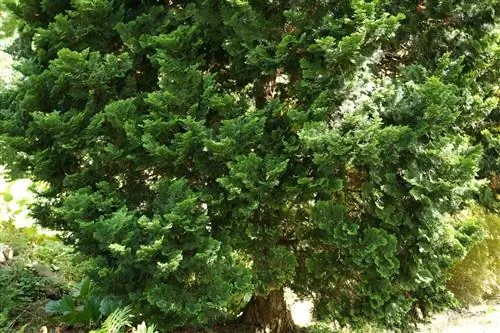
The further treatment steps are as follows:
- Planting a plant
- cut rotten root areas generously
- Let the root ball dry for several days
- Prepare the planter with fresh substrate
- Replanting the plant
Then watering should be suspended for at least another week to kill the remaining fungal and bacterial spores.
Instinct death
Shoot death is characterized by dying shoots that are also covered in numerous black dots. The fungal infestation is caused by branches that are too moist in conjunction with a low outside temperature. For effective treatment, we recommend using a special fungicide, which can be purchased from specialist retailers. The infected plant parts should under no circumstances be disposed of in the compost, otherwise there is a risk of renewed infection.
Thuja leaf miner
An infestation with the Thuja leaf miner can be recognized by withered branches and scattered traces of droppings. The larvae of the moth species in particular prefer conifers because they store a large amount of plant sap in their shoots all year round. However, combating insects is very easy using sticky traps, meaning that no further measures are often necessary.

